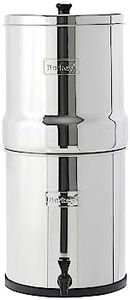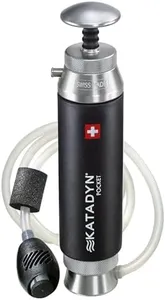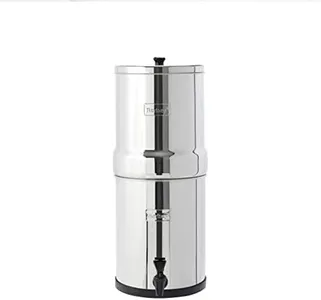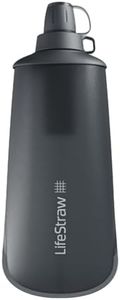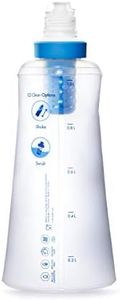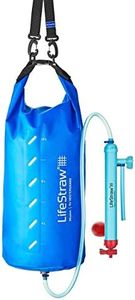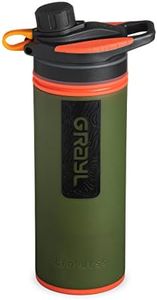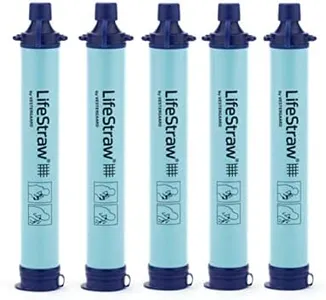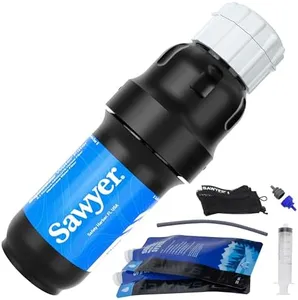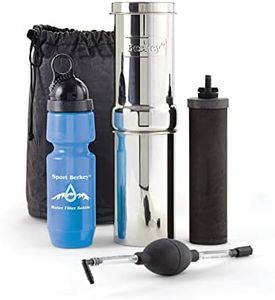We Use CookiesWe use cookies to enhance the security, performance,
functionality and for analytical and promotional activities. By continuing to browse this site you
are agreeing to our privacy policy
10 Best Survival Water Filter
From leading brands and best sellers available on the web.Buying Guide for the Best Survival Water Filter
Choosing a survival water filter is an important step for anyone who spends time outdoors, travels to remote areas, or wants to be prepared for emergencies. The main goal of a survival water filter is to make contaminated water safe to drink by removing harmful substances. When picking a filter, you need to consider the types of contaminants you might encounter, how portable the filter is, its ease of use, and how much water you’ll need to purify at one time. Matching these points to your specific needs—such as where you’ll use it, for how many people, and for how long—will help you make the best choice.Filtration TechnologyFiltration technology refers to the method the filter uses to clean the water. Common types include hollow fiber membranes, activated carbon, ceramic filters, and UV light purification. Each has its benefits: hollow fiber and ceramic are very effective against bacteria and protozoa, while activated carbon filters can reduce chemicals and improve taste. UV light can kill viruses, which can be a concern in certain locations. Think about where you’ll be using the filter—if virus protection is necessary (such as international travel), you’ll need a more comprehensive system. For most natural water sources in North America and Europe, bacterial and protozoa protection is usually enough.
Pore SizePore size is a measurement, usually in microns, that tells you how small of a contaminant the filter can block. Most survival filters have pores between 0.1 and 0.4 microns, which are small enough to trap bacteria and protozoa. Smaller pore sizes provide more protection, but can sometimes slow down water flow. If you are mostly concerned about bacteria and parasites, look for a filter rated around 0.2 microns. If viruses are your concern, you may need an additional purification method like chemical treatment or UV light.
Capacity and Flow RateCapacity means how much water the filter can clean before the filter element needs to be replaced, while flow rate is how quickly water passes through the device. Smaller, lighter filters are designed for individual use and may only filter a few hundred to a thousand liters. Larger filters and gravity bags are great for groups, offering higher capacity and flow rates for filling bottles or cooking water. If you’re hiking alone or only for short periods, a compact, lower-capacity filter is fine. For family trips, group camping, or long-term emergency use, a higher-capacity system with a fast flow rate is more convenient.
Weight and PortabilityWeight and portability indicate how easy it is to carry the filter with you. Compact straw-type filters and small pump filters are lightweight and fit in a backpack pocket, making them perfect for solo hikers and emergency kits. Heavier filters, like bulk gravity-fed systems, are better for base camps where you aren’t moving often and need to provide water for several people. Consider how much weight you can carry and how much space you have when making your choice.
Ease of Use and MaintenanceEase of use and maintenance refers to how simple the filter is to operate and keep clean. Some filters require pumping, others need to be used as a straw, and some function by filling a bag and letting gravity do the work. Maintenance can include backwashing (flushing the filter with clean water), replacing cartridges, or simply drying out parts. If you prefer hassle-free operation, look for filters with low maintenance needs. For longer trips or unknown water quality, pick a filter that can be easily cleaned in the field to extend its life.

